Disclaimer: This review for Ninja Gaiden: Ragebound was conducted with a PC review code. Nintendo Wire accepted the code to have an early review under the assumption that the Switch port would not offer a dramatically different experience. The day before embargo, Dotemu confirmed that the Switch version will “average a 30 fps experience at launch,” which would have adversely affected my view of the game.
I felt the need to include this disclaimer as review codes for the Switch version were not available before launch. While I will try to offer a look at that version in the coming days, this review is left as is because it reflects my experience of the game under ideal conditions. Once the Switch version is updated, this will hopefully turn into a non-issue.
To gamers of a certain age, the name “Ninja Gaiden” will either elicit cries of joy or screams of pain. Known for a trilogy of brutally tough action games on the NES and then a reboot trilogy of near equal brutality on more modern consoles, Ninja Gaiden has become synonymous with hardcore hack-and-slash action. The games are carefully crafted with an emphasis on skill checks, high precision, and pattern recognition. That’s probably why the series fell out of favor following the release of 2012’s Ninja Gaiden 3… or maybe it was because that game wasn’t very good.
Whatever the case, Ninja Gaiden has become a fan-favorite and stands as one of Koei Tecmo’s most cherished franchises. That’s what made the announcement of Ninja Gaiden: Ragebound at The Game Awards 2024 so shocking. After a decade since the last game (2014’s infamous Yaiba: Ninja Gaiden Z), Koei Tecmo was finally welcoming back the king of action games to its lineup. It might star a new hero and be a throwback to the classic platformer days, but it was still Ninja Gaiden! The only thing that could make 2025 better would be a new 3D game — which then got announced the following month.
Developed by indie studio The Game Kitchen, known for its popular Blasphemous games, Ragebound entered development roughly halfway through the production of Blasphemous II. Publisher Dotemu had been given a blessing by Koei Tecmo to produce a new Ninja Gaiden game and then turned to The Game Kitchen as it had been impressed by its previous work. The team had actually wanted to integrate some of the 3D games’ combat into this installment, but couldn’t manage to get it working. It quickly pivoted to recapturing the essence of the NES trilogy, which had more of an emphasis on players barreling through levels after learning enemy patterns and maintaining a constant rhythm.
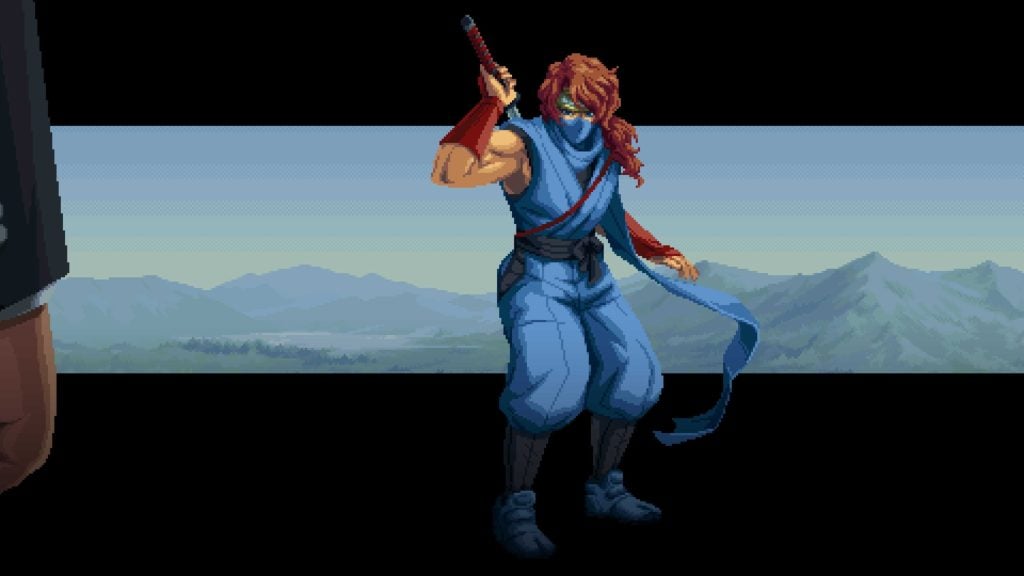
The end result? Ragebound feels like an updated take on those classic NES games. Longtime fans will probably be a little disappointed that this newest game isn’t brutally difficult, but it otherwise plays like what a modern Ninja Gaiden title would realistically be. One of my first thoughts from the preview trailer was that Ragebound was a lost Sega Saturn platformer and that initial reaction rang true as I plowed through the game’s various levels. It certainly renders in a higher resolution than a Saturn game could, not to mention has modern conveniences like autosaving and control rebinding, but this is otherwise a golden era action platformer.
The general plot of Ninja Gaiden: Ragebound follows new Hayabusa clan recruit Kenji Mozu, but it actually functions as a series reboot. The first level lets players assume control of Ryu Hayabusa’s father, Jo, as he enters his fateful duel against Bloody Maith. After being killed in action, news is delivered to the Hayabusa clan as Ryu trains Kenji. A new demon menace threatens the world and only the Hayabusa clan can thwart it. Their longtime rivals, the Black Spider Clan, are attempting to capitalize on the demon outbreak, so Ryu sends Kenji to check it out.
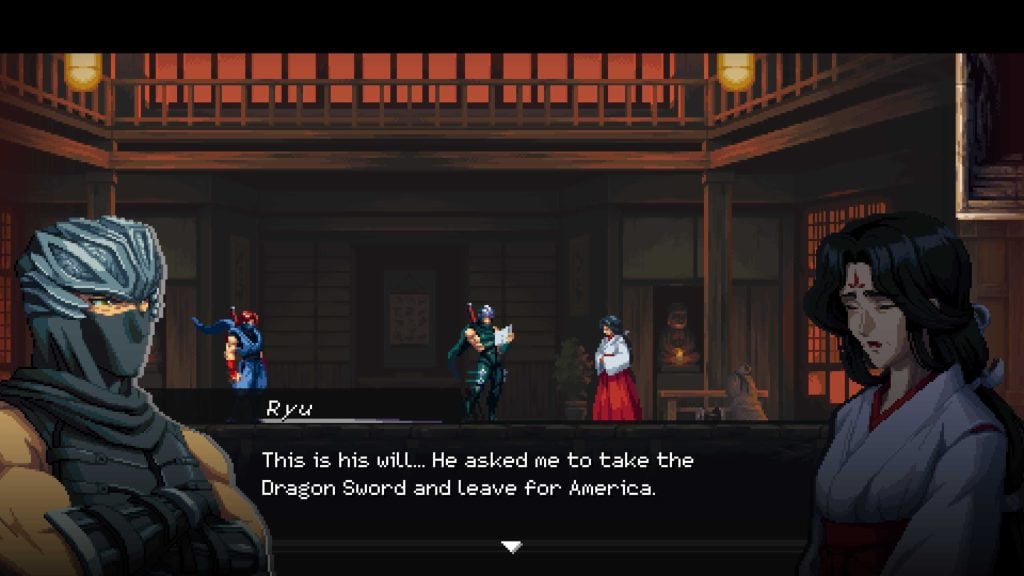
Initially, the game gives you a hyper limited set of moves when controlling Jo. It’s not really a tutorial, so to speak, but I thought Ragebound might not stick the landing. Jo is exceptionally limited, having only a basic sword attack at his disposal. What this level does introduce pretty elegantly is the ability to not only climb on walls (which was a staple of the NES titles), but to hang from certain platforms or ceilings. The physicality of the main character in Ragebound is upgraded over the original games, allowing for some neat bits of platforming later on.
When you do get to control Kenji, however, the game opens up considerably. Kenji not only has Jo’s moveset, but the ability to do what’s called a “Guillotine Boost” to jump off of enemies and damage them in the process. Kenji can also dodge past attacks with a roll that even serves a function during exploration. If you want to feel even more like a badass ninja, Kenji can outright deflect attacks by striking them, meaning good timing and dexterity can nullify almost every enemy attack. That likely contributes to the somewhat lessened difficulty here over the NES trilogy, but it strengthens the power fantasy immensely.
Towards the end of the third level, Kenji nearly falls in battle against a devastating foe and comes face-to-face to Black Spider Clan kunoichi Kumori. Having nearly met the same fate herself, Kumori explains how she wound up in her current position and Ragebound flashes to a stage with her. Kumori controls mostly the same as Kenji, but her main weapon is throwing kunai. She also has access to “Spider Weapons,” which perform similarly to the sub-items you’d get in the NES games. The press of a button will activate a throwing star, chakram, and other unlockable items to aid you in battle. The change of pace is fun, especially since Kumori’s segment puts more of an emphasis on vertical traversal, but Ragebound has a trick up its sleeve: combining its hero’s powers.
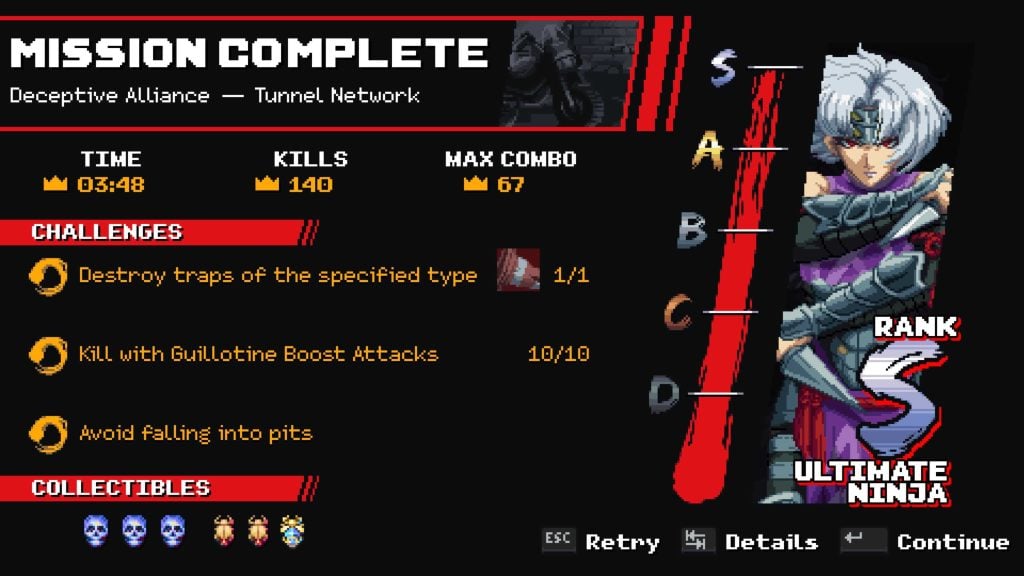
The major twist of Ninja Gaiden: Ragebound is that players will control Kenji for the majority of the game, but be able to utilize Kumori’s powers through some type of black magic. Since she has no recourse left, she fuses her soul with Kenji and the two team up to stop the demonic threat looming down on them. Kenji’s moveset now expands to include everything Kumori can do, making him feel like something of a wrecking ball. Up close combat is fast and furious with enemies mostly dying in a single hit. Certain enemies will be stronger, but you can enter a “Hypercharge” state by either sacrificing some health or killing enemies with a specific aura. It makes planning out your attacks important as you can keep momentum going through quick reaction. You even unlock “Rage Arts” before long, which let you expend a special meter for a screen clearing attack or one that heavily damages bosses.
That’s really the gist of what Ragebound nails so well. It might not be overwhelmingly tough to get through, but it feels incredible when you fully grasp the mechanics at play and get into a groove. There’s a particular level during Act Three where a remix of Keiji Yamagishi’s “The Amazing Ryu” kicks in and a huge grin crossed my face. It sparked a fury in me where I almost zoned out and proceeded to floor everything in my path. Even the more involved platforming in that level, which requires you to hang from platforms dangling over a bottomless pit while enemies fly by, didn’t phase me. I had entered the zen-like groove that the NES games take you to so often.
The campaign in Ninja Gaiden: Ragebound has some varied locations for players, never really repeating the same trick twice. The opening areas are kind of what you’d expect from an action game, but soon you’ll be jumping across a bullet train, speeding around on a motorbike, and scaling heavily guarded towers complete with turrets and flying drones. The enemy roster is similarly diverse, though not overwhelmingly so. You will dispatch everyone the same way, but their attack patterns, weapons, and placements are what gives the combat depth. The boss fights, though, are where Ragebound gets the majority of its difficulty from.

Not every level ends with a climactic showdown, but for the ones that do, you’ll often square off with an enemy that takes up a sizable portion of the screen. Their attacks hit hard and the main focus will be on learning those patterns before you can really make a dent in the health bars. Each one has its own unique quirks and arenas, meaning you can’t rely on the same strategies. At times, they reminded me of the encounters from Super Meat Boy, but then no boss is really that long. There isn’t a lot of waiting around for attacks to happen, and while you can’t be proactive like in The Messenger, the fights mimic the pacing of the original NES games. It helps that Ragebound allows players to equip different items, meaning you can cater the experience to your specific playstyle.
While Kenji cannot change out his sword or Guillotine Boost, Kumori is able to change her sub-weapon and Rage Art. I didn’t play around too much with this as I built a skillset around some specific charms, but having the ability to regain some health once you get a kill counter above three or even having an outright healing ability as your Rage Art means you won’t need to suffer during tough segments. If that isn’t enough, Ninja Gaiden: Ragebound also includes an accessibility menu that lets you tweak the game speed, decrease damage received from enemies (down to 0%, even), or increase the size of your Guillotine Boost. There isn’t a difficulty selection when starting, and even though you unlock a Hard Mode upon completion, the game is easily customizable with regards to challenge.
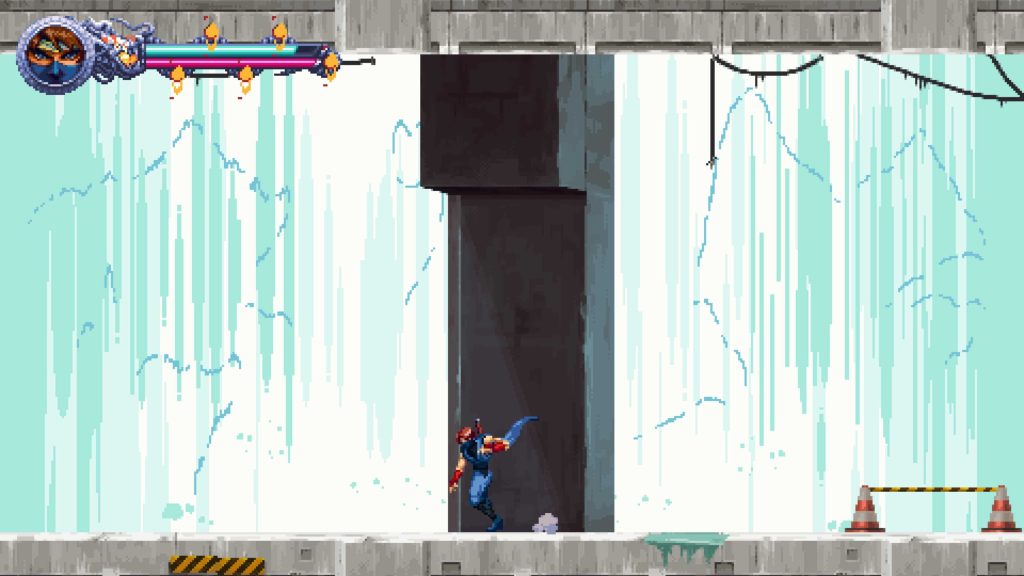
Stuff like this is certainly appreciated, but it’s maybe also what didn’t ingratiate Ragebound to me as much. Don’t get me wrong, I enjoyed my time through Ragebound. I’m also especially happy that the campaign is a little over five hours long, not bloating things out unnecessarily to justify some price point or length. The thing is, Ragebound is entering into the industry at a point where homages and callbacks to classic NES games are at a saturation point. If something like The Messenger never existed, maybe I’d have fallen in love with Ragebound. I’m happy that this newest Ninja Gaiden is a straight platformer instead of shifting into a Metroidvania at the mid-point, but then the early segments of The Messenger completely scratched the itch I had for classic Ninja Gaiden so well.
You also have other games to consider, such as Cyber Shadow or Mark of the Ninja. This isn’t a fault of The Game Kitchen or even Koei Tecmo. What is presented here is of a high quality and is a blast to play through. Had this game been released around 2008 when Capcom struck gold with Mega Man 9, I think fans would remember it as one of the best retro-platformers ever. While my personal nostalgia for the NES trilogy remains strong, I have to concede that Ragebound simply has more to it. There’s unlockable secret levels and a wealth of collectibles to find, giving you more incentive to replay levels. You even have some challenges you can complete, though these only affect end-level ratings. Still, this game simply isn’t as fresh as it would have otherwise been years ago.
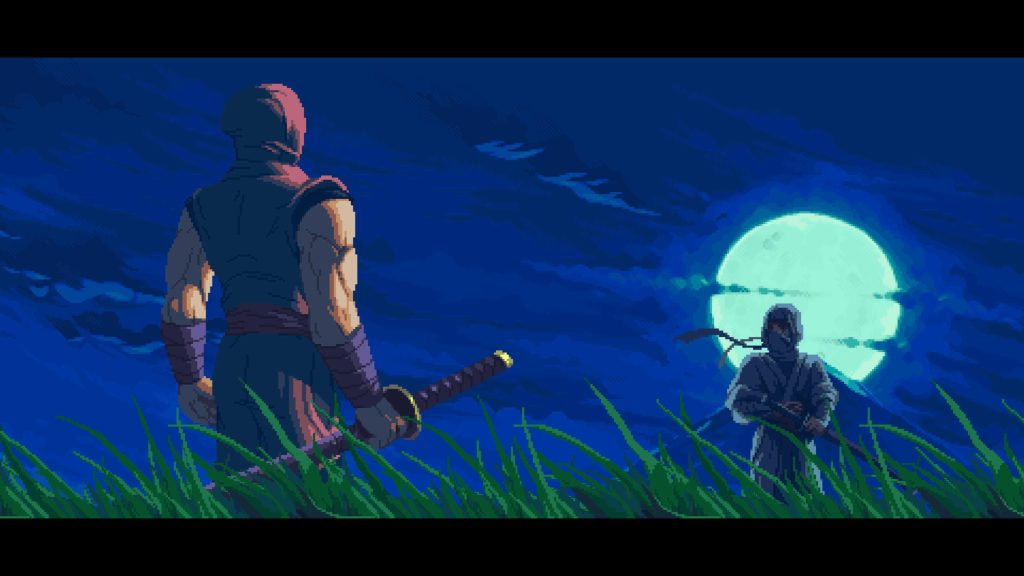
If you want a “real” complaint, sometimes Kenji sticks to walls a bit too readily. It’s hardly game breaking, but I did find a few situations where I had wanted to jump past a platform only to latch onto it. It did kill me once, but it’s not like it made segments harder than they needed to be. It’s really only frustrating in the time-limited Kumori bits where you’re racing against a ticking clock and Kumori decides she wants to hang from the ceiling. I, too, like to raise the roof from time to time, but we’ve got work to do, Kumori!
Some people might read this and tell me to stick to “objective” criticism, but that isn’t how game reviewing works. If I were to simply lay out a checklist of what Ninja Gaiden: Ragebound has, it would be no different than a press release. It also wouldn’t give you an idea of the experience I had playing it, which was a blast of a few hours that made me reminisce about the old days only to then wake up to the reality of our current world. There are fans that will find Ragebound’s more approachable difficulty preferable to the classics, and it certainly has more variation in its levels. Still, it won’t redefine what is possible with Ninja Gaiden or even action platformers. I guess my own expectations were a bit too high.
Leave a Comment

System: Nintendo Switch
Release Date: July 31, 2025
Categories: Action
Publisher: Dotemu
Developer: The Game Kitchen


